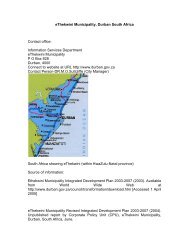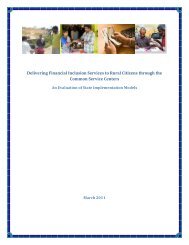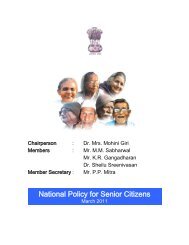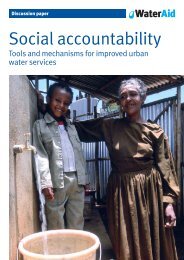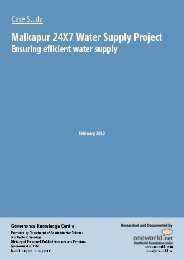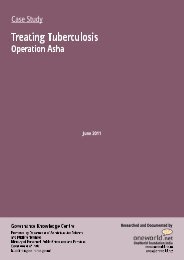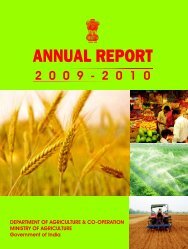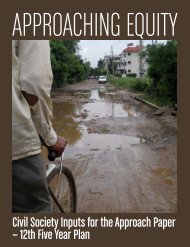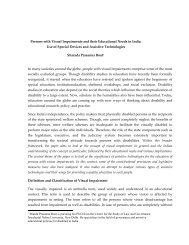EMRI model - Indiagovernance.gov.in
EMRI model - Indiagovernance.gov.in
EMRI model - Indiagovernance.gov.in
You also want an ePaper? Increase the reach of your titles
YUMPU automatically turns print PDFs into web optimized ePapers that Google loves.
Study of Emergency Response Service (<strong>EMRI</strong> Scheme)ceil<strong>in</strong>gs nor any m<strong>in</strong>imum levels nor any targets. Indeed it does not even declare thetrips it has made, though it sends a daily sheet of ambulance trips from which the<strong>gov</strong>ernment could estimate the payment to be made- which no <strong>gov</strong>ernment has everbeen able to do. Governments have no idea about the staff strengths deployed, or evenwhat funds are committed or unit costs permissible per ambulance or per kilometretravelled etc. The <strong>EMRI</strong> thus has a commitment from the <strong>gov</strong>ernment that it can spendwhatever it takes on operational costs and even on capital costs, and this would be paidfor <strong>in</strong> advance. This is not spend and reimbursement arrangement- but advancepayment arrangement.i. Operat<strong>in</strong>g costs are currently approximately Rs 15 to Rs 17 lakhs per ambulance peryear (<strong>in</strong>clud<strong>in</strong>g an annualised replacement cost of approx. Rs. 3 to 5 lakhs peryear).These costs could be expected to rise further. Thus the currently estimated Rs.1700 crores required per year for a projected fleet of 10,000 ambulances needednationwide (account<strong>in</strong>g for around one ambulance per lakh population) could f<strong>in</strong>ally betwo to three times this amount. Susta<strong>in</strong>ability would thus become a major issue.j. However Rs 1700 crores per year needed for nationwide coverage is only around 10%of current NRHM annual budget and would be only about 3% of the promised Rs 55,000crore per year that was projected as the level of public expenditure on NRHM that was tobe reached by 2012. Even if we take a higher level of utilisation, then it would be about5% of the NRHM budget. In a scenario where the commitment to raise health careexpenditure to 3% of the GDP is adhered to, this Rs 1700 to Rs 3000 crorescommitment would help reach this goal. On the other hand if the cost spent on healthcare provision does not rise as it should, this outlay would be too high andunsusta<strong>in</strong>able.4. Governance and Management:a. The <strong>EMRI</strong> has been procured as a s<strong>in</strong>gle agency <strong>in</strong> most states without a tender<strong>in</strong>gprocess. Whereas <strong>in</strong> Andhra, <strong>in</strong> the early phase this was a partnership with Satyambr<strong>in</strong>g<strong>in</strong>g <strong>in</strong> <strong>in</strong>vestment, subsequently the project became 100% <strong>gov</strong>ernment fundedcapex and 95% <strong>gov</strong>ernment funded opex. With even this small 5% not turn<strong>in</strong>g up, it isnow a 100% <strong>gov</strong>ernment funded opex.b. Most of the MOUs have the provision of declar<strong>in</strong>g it a monopoly provider. This is also notan essential feature for success. Potentially one could have a system of multipleownership of ambulances, with a s<strong>in</strong>gle call center (like the call taxi systems), or a mix ofpublic or private or even more than one provider <strong>in</strong> a state. Of course regulation wouldbe essential for efficiency so that there is only one operator for a given area. However tothe extent that by virtue of 100% ownership <strong>EMRI</strong> would need to <strong>in</strong>creas<strong>in</strong>gly abide by<strong>gov</strong>ernment f<strong>in</strong>ancial regulations and soon face all the attendant HR issues as well, onemay well reth<strong>in</strong>k even this aspect of it.National Health Systems Resource Centre (NHSRC)30




